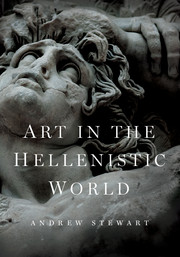Book contents
- Frontmatter
- Contents
- List of Illustrations
- Preface
- Introduction
- 1 Settlement
- 2 Power
- 3 Victory
- 4 Benefaction
- Focus I The Great Altar of Pergamon
- Focus II Hellenistic Mosaics
- Appendix A The Artist
- Appendix B Kallixeinos of Rhodes on the Wonders of Alexandria
- Glossary
- Timeline
- Biographical Sketches
- Select Bibliography and Further Reading
- References
- Sources of Illustrations
- Index
4 - Benefaction
Published online by Cambridge University Press: 05 October 2014
- Frontmatter
- Contents
- List of Illustrations
- Preface
- Introduction
- 1 Settlement
- 2 Power
- 3 Victory
- 4 Benefaction
- Focus I The Great Altar of Pergamon
- Focus II Hellenistic Mosaics
- Appendix A The Artist
- Appendix B Kallixeinos of Rhodes on the Wonders of Alexandria
- Glossary
- Timeline
- Biographical Sketches
- Select Bibliography and Further Reading
- References
- Sources of Illustrations
- Index
Summary
In summer, 334, Alexander passed by Priene on his march down the Aegean coast (see Maps 1 and 2) and stopped long enough to turn his attention to its new Ionic temple (Figure 5). His dedicatory inscription (Figure 9), inscribed on one of the temple’s spur walls, or antae, probably commemorates a cash benefaction (euergesia) to relieve a funding crisis and complements another decree of his exempting the city from donating to his crusade.
It also neatly killed two birds with one stone, because Athena was the expedition’s patroness, and she and her temples at Athens (including the Parthenon) and elsewhere had already benefited greatly from Alexander’s generosity. In addition to enlisting her aid as goddess of war and victory, his gifts helped avenge the Persian outrages of 480, including their sack of the Akropolis; furnished concrete proof of his impressive power of agency; and discreetly created a sense of obligation among their recipients. As will appear, ulterior motives of this sort were common in such cases. Gifting is a technology of power.
Yet Priene’s temple still took two more centuries to complete (Figure 47). In 156, King Orophernes of Cappadocia in southern Anatolia apparently funded a new cult statue for it modeled on Pheidias’s mighty Athena Parthenos, which had been dedicated in the Parthenon in 438. A half-sized, cut-price version of this Pheidian gold and ivory colossus, the Priene statue featured only gilded wooden drapery and marble flesh. For obvious reasons, this venerable and conveniently economical akrolithic technique flourished during the Hellenistic period. A benefaction from a second Cappadocian king later financed another of Priene’s public buildings, and wealthy private donors and public subscriptions funded yet more.
- Type
- Chapter
- Information
- Art in the Hellenistic WorldAn Introduction, pp. 86 - 104Publisher: Cambridge University PressPrint publication year: 2014



